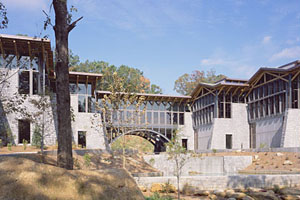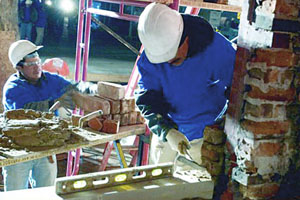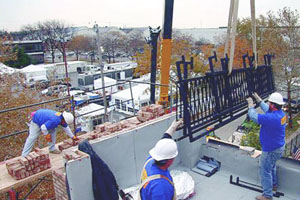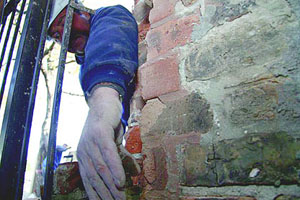A Green Look at Masonry
By Brett Martin

Recycled construction materials, including brick and stone, are becoming more prevalent, and for good reason. Recycling reduces the amount of construction waste, which is significant; construction waste is the most common garbage going into landfills. While concrete and rubble make up about half of the construction waste, bricks only comprise 1 to 5 percent.
The U.S. Environmental Protection Agency (EPA) estimates that 136 million tons of construction and demolition waste was generated in 1996, the last year these figures were made available. Most of the waste came from demolition and renovation, while the rest came from new construction. Less than 30 percent of that waste was salvaged for recycling.
Contractors who do use salvaged materials say it adds an extra element to their projects.
"[Recycled materials] have a purpose," said Fred Mahler, owner of Mahler Construction Co. Inc. of Lake Barrington, Ill., who has used salvaged bricks on projects. "We're saving Mother Earth."
A patchwork of city and state ordinances and legislation are now requiring more recycling of construction materials, some based on the LEED model. For example, Chicago requires all city buildings to be constructed to LEED standards. Chicago also recently adopted an ordinance requiring a certain percentage of construction and demolition waste to be recycled — 25 percent for projects that had a permit issued in 2007, and 50 percent if the permit is issued in 2008.
LEED has also caught the attention of architects and builders. One project being considered for LEED gold level certification is the Gwinnett Environmental & Heritage Center in Buford, Ga., a 59,000-square-foot building that employs several green design strategies (pictured on pages 32-33). It's designed to use 75 percent less potable water and 35 percent less energy than a conventional building.
"It's a living, dramatic example of sustainable building practices," said Meg Needle, AIA, LEED AP, an associate with the architectural firm Lord, Aeck & Sargent in Atlanta, and project manager for the Center.
In addition to a 40,000-square-foot green roof that reduces the building's air conditioning requirements, clerestory windows that provide natural sunlight and water-saving plumbing strategies that are projected to save 316,000 gallons of potable water annually, the building's exterior is clad with salvaged granite from nearby Elberton, Ga.; the granite was left over from companies that build gravestones, a popular business in the area.
By using a natural resource available locally, Needle's firm was able to secure LEED points for the recycled granite.
"Granite is just a great material. It is so sustainable that it holds up and looks good without showing signs of wear," Needle said. "It's a valuable asset. This post-industrial recycled material has so much to offer."

The program showcased the renovation of a house for Geno and Melinda Noyola and their six children. After purchasing their home, the Noyolas discovered major problems and couldn't move in, so "Extreme Makeover" and contractors stepped up to remodel the home. The project had to follow some green building rules, but the trickier part was meeting an extraordinarily tight building schedule.
"They don't give you much time," Mahler said of the seven days afforded to complete the entire job — Mahler Construction Co. had just three days and nights for the masonry work. "It was a very tense time, but during the process, you felt so good about being involved. It was a good feeling."
Prior to installing the recycled bricks on the project, Mahler's crews had to make sure they were sound.
"You have to be careful. Some of the bricks are very soft," he said. "You can tell if a brick is sound or not sound by feeling it and looking at it."
While many masonry materials can be reused in the applications for which they were originally intended, they also can be recycled for other applications as well. Vintage Brick Salvage LLC in Rockford, Ill., which specializes in reclaimed Chicago brick, buys salvaged materials from building demolition contractors throughout Northern Illinois and puts them to an unusual use. The company slices the bricks into half-inch-thick tiles.
"You can install them on wallboard or put them on the floor," said Tom Svoboda, president of the company. "A lot of the tile is used in businesses, like restaurants, for fireplace surrounds and brick floors."
Incorporating recycled materials into the building design can also be good for business, since a growing number of clients now desire green buildings.
"It's becoming a coveted thing to have [green buildings] in your portfolio," Needle said. "There's a perceived value for clients. It's really aligned with how they want their buildings designed."

"The primary reason we go to salvage is to match what's already on the building. Usually, if you want something historic, you need to use salvaged materials," said Jeffrey Frake, vice president of the Masonry Preservation Group Inc., in Merchantville, N.J. "You just flat out can't get a match for it any other way."
Sometimes, a building is dismantled and the brick is salvaged and used to reconstruct a new building or complete a remodeling job that will have the same exterior as the rest of the structure, Frake said, citing his company's work with Princeton University in New Jersey, as an example. Bricks from buildings that are taken down on campus are either reused immediately or stored to be reused later.
"They're really fussy about reusing the material," Frake said. "They never throw anything away."
Salvaged masonry materials also give buildings, even new buildings, a historic look.
"The aesthetics is really the benefit," Svoboda explained. As it states on his company's website, "An authentic, time worn, reclaimed brick is impossible to duplicate. Using antique brick in a new project or remodeling job will create a space that conjures up the feeling of a century-old structure, even in a brand new installation."
Most of Svoboda's customers buy his brick tiles for their look and ease of installation, not because they're environmentally friendly. "The benefit of salvaged brick tile is aesthetics and it's easy to install. A certain percentage of businesses want it because it's green," he said, stating that approximately 25 percent of his customers are interested in the green aspect.
Trade associations representing the brick and stone industries also endorse the idea of reusing materials.
"We think it's wonderful. It adds a lot of character to the project itself," said Jeff Buczkiewicz, executive vice president of the Building Stone Institute (BSI) in Elgin, Ill. "It gives you an idea of how long the stone will last. It's truly a product that will live forever."
Some BSI members specialize in recycled and salvaged materials, including members who are bringing 100-year-old stone to the United States from China, Buczkiewicz said. Others are reclaiming pavers from historic areas, such as in Philadelphia where Benjamin Franklin may have walked, because of their uniqueness.
"It kind of gives you a neat feeling," Buczkiewicz said of reusing the historic pavers.
The Brick Industry Association (BIA) in Reston, Va., also supports reusing materials. "Certainly we support recycled brick. It has its advantages," said Stephen Sears, director of marketing and communications for BIA. "One of the benefits of brick is that it can be reused."
However, he adds that salvaged bricks may not be as strong as new bricks. "From a performance perspective, the new bricks are much more consistent because the manufacturing process is more stringent," Sears said. "You can replicate that charm [of recycled bricks] with new bricks that you know for sure will meet the codes."

"The specifier needs to be sure what is realistic [concerning] what is salvageable," he said.
High prices for salvaged materials can also present a challenge. "The cost of demolition is exponentially greater than buying new brick. You're performing surgery and have to handle with care," Frake said. "When it comes to salvaging historic brick, point one and point two are it's not going to save money from a labor standpoint."
After bricks are salvaged, general labor is needed to clean them and remove old mortar. "It costs $400 a day for labor, before you make a nickel cleaning the brick," Frake said.
Getting reusable materials to the building also can be problematic, such as in the case of the Gwinnett Environmental & Heritage Center project.
"A big challenge was transporting the heavy materials the 80 miles to the job site," Needle said. That issue was solved with heavy-duty trucks.
Another challenge, installing masonry ties that wouldn't disturb the insulation, required a slightly different anchoring system. Two, L-shaped anchor clips were screwed to the wall, then a 3/8-inch galvanized bar slid through the holes in the clips. A seismic tie was then attached to the bar (pictured on page 36). "It's the first time I've ever seen something like this," said Jim Sullivan, president and CEO of Sullivan Stone in Conyers, Ga., and the mason contractor on the project.
Needle emphasized the importance of keeping the rigid insulation intact. "We needed a system that allowed the masons to anchor without butchering the insulation," she said.
Sullivan Stone had four crews of six men working on the project. Since the granite weighed a hefty 180 pounds per cubic foot, setting it took time. "It doesn't go up quickly," Sullivan said.
Bidding the project, however, was business as usual. "I bid it by the square foot," he said. "It's not hard to count bricks and sticks at the end of the day."
About the Author
Brett Martin is a freelance writer located in Shakopee, Minn. with several years of construction and writing experience.


















